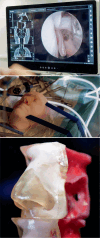[Development of paranasal sinus surgery in Austria and Switzerland: past, present, and future]
- PMID: 39747672
- PMCID: PMC11711146
- DOI: 10.1007/s00106-024-01539-3
[Development of paranasal sinus surgery in Austria and Switzerland: past, present, and future]
Abstract
Thanks to our predecessors and technical progress, we can nowadays offer our patients a safe and modern paranasal sinus surgery. This article provides an overview of the historical development of paranasal sinus surgery in Austria and Switzerland and to shed light on the dynamic progress of this discipline in an international context. Paranasal sinus surgery has undergone significant change in recent decades, driven by rapid technological advances that have significantly improved surgical procedures and operative outcomes. While indications were originally limited to treatment of inflammatory diseases, today, endoscopic procedures cover interventions in the area of the anterior skull base, the orbit and sinonasal tumors. The concept of functional endoscopic sinus surgery (FESS) may seem simple, but the anatomic variability, especially in the area of the frontal sinus, as well as the wide spectrum and severity of diseases can be a challenge. Therefore, paranasal sinus surgery should not be a casual operation and should only be performed by well-trained surgeons to prevent disease recurrence as well as medical and economic follow-up costs. Standardized surgical training for aspiring paranasal sinus and skull base surgeons is critical. Preoperative planning through systematic analysis of CT images is an essential factor to achieve optimal results and to avoid intraoperative complications. The pathophysiological understanding of sinonasal disease and the recent developments of new drug therapies such as monoclonal antibodies also enable excellent results in the small subgroup of patients who do not benefit from a combination of surgical rehabilitation and long-term drug therapy. The dynamic development of endoscopic paranasal sinus surgery in recent decades shows the potential of the field for the coming decades.
Unseren Vorgängern und dem technischen Fortschritt ist es zu verdanken, dass wir heute unseren Patienten eine sichere und moderne Nasennebenhöhlen(NNH)-Chirurgie anbieten können. Die vorliegende Arbeit gibt einen Überblick über die geschichtliche Entwicklung der NNH-Chirurgie in Österreich und der Schweiz und über den dynamischen Fortschritt dieser Disziplin im internationalen Kontext. Während die Indikation ursprünglich auf die Therapie von entzündlichen Erkrankungen begrenzt war, sind heute endoskopische Eingriffe im Bereich der vorderen Schädelbasis, der Orbita und auch von sinunasalen Tumorerkrankungen möglich, was zu einer geringeren Morbidität geführt hat. Das Konzept der funktionellen endoskopischen NNH-Chirurgie (FESS) mag einfach erscheinen, aber die Variabilität der Anatomie der NNH und das breite Spektrum der Krankheiten stellen eine Herausforderung dar. Daher sollte die NNH-Chirurgie keine Gelegenheitsoperation sein und nur von gut ausgebildeten Chirurgen durchgeführt werden, um Krankheitsrezidiven und ökonomischen Folgekosten vorzubeugen. Ein standardisiertes chirurgisches Training für angehende NNH- und Schädelbasischirurgen ist von entscheidender Bedeutung. Die präoperative Planung mittels systematischer Analyse der Computertomographie(CT)-Aufnahmen ist ein wesentlicher Faktor, um optimale Ergebnisse zu erzielen und intraoperative Komplikationen zu vermeiden. Das pathophysiologische Verständnis von sinunasalen Erkrankung und neue medikamentöse Therapien wie monoklonale Antikörper ermöglichen auch jener kleinen Subgruppe von Patienten, die von einer Kombination aus operativer Sanierung in Kombination mit medikamentöser Langzeittherapie nicht profitieren, exzellente Ergebnisse. Die dynamische Entwicklung der endoskopischen NNH-Chirurgie in den letzten Jahrzehnten zeigt das Potenzial dieses Bereichs für die kommenden Dekaden.
Keywords: Endoscopic sinus surgery; Endoscopic skull base surgery; Preoperative planning; Surgical training; Technological advances.
© 2024. The Author(s).
Conflict of interest statement
Einhaltung ethischer Richtlinien. Interessenkonflikt: E. Vyskocil, A. Wolf und D. Hinder geben an, dass kein Interessenkonflikt besteht. Für diesen Beitrag wurden von den Autor/-innen keine Studien an Menschen oder Tieren durchgeführt. Für die aufgeführten Studien gelten die jeweils dort angegebenen ethischen Richtlinien.
Figures







Similar articles
-
Analysis of ethmoid roof and skull base with coronal section paranasal sinus computed tomography.J Craniofac Surg. 2012 Sep;23(5):1460-4. doi: 10.1097/SCS.0b013e31825755b2. J Craniofac Surg. 2012. PMID: 22976636
-
Preoperative computed tomography evaluation in sinus surgery: a template-driven approach.Otolaryngol Clin North Am. 2010 Aug;43(4):731-51. doi: 10.1016/j.otc.2010.04.020. Otolaryngol Clin North Am. 2010. PMID: 20599079
-
[Diagnostic value of computer tomography of paranasal sinuses in qualifying for functional endoscopic sinus surgery (FESS)].Otolaryngol Pol. 1994;48(6):521-6. Otolaryngol Pol. 1994. PMID: 7870422 Polish.
-
Computer-aided surgery of the paranasal sinuses and skull base.Expert Rev Med Devices. 2005 Jul;2(4):395-408. doi: 10.1586/17434440.2.4.395. Expert Rev Med Devices. 2005. PMID: 16293079 Review.
-
Prevention and management of vascular injuries in endoscopic surgery of the sinonasal tract and skull base.Otolaryngol Clin North Am. 2010 Aug;43(4):817-25. doi: 10.1016/j.otc.2010.04.008. Otolaryngol Clin North Am. 2010. PMID: 20599086 Review.
References
-
- Nager F (1919) Operation des Hypophysistumors nebst Bemerkungen zur Chirurgie der Schadelbasis. Corresp Bl Schweizer Aerzte 35:1289–1359
-
- Nager F (1940) The paranasal approach to intrasellar tumours. J Laryngol Otol 55:361–381
-
- Mosher HP (1929) LXXII. Symposium on the ethmoid: the surgical anatomy of the ethmoidal labyrinth. Ann Otol Rhinol Laryngol 38:869–901
-
- Heermann H (1958) Über endonasale Chirurgie unter Verwendung des binocularen Mikroskopes: Mit 2 Textabbildungen. Arch Ohren Nasen Kehlkopfheilkd 171:295–297 - PubMed
-
- Masing H (1976) Surgery on the lateral nasal wall with the operation microscope. Rhinology 14:73–77 - PubMed
Publication types
MeSH terms
LinkOut - more resources
Full Text Sources
Miscellaneous

